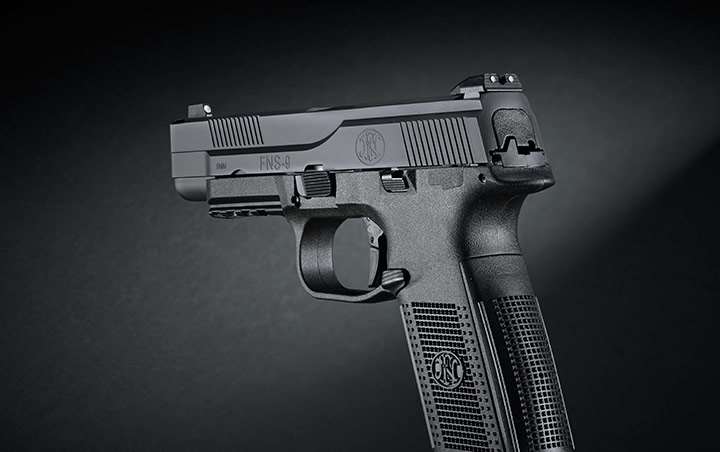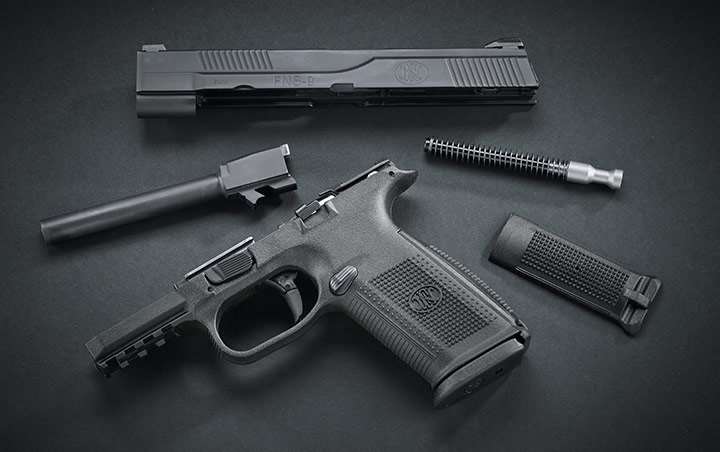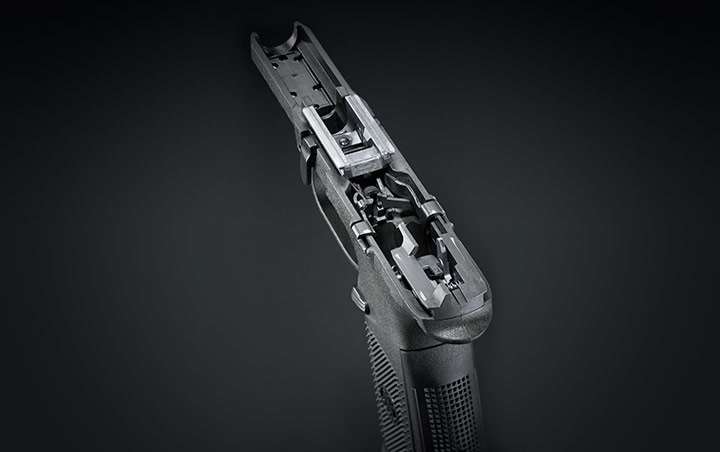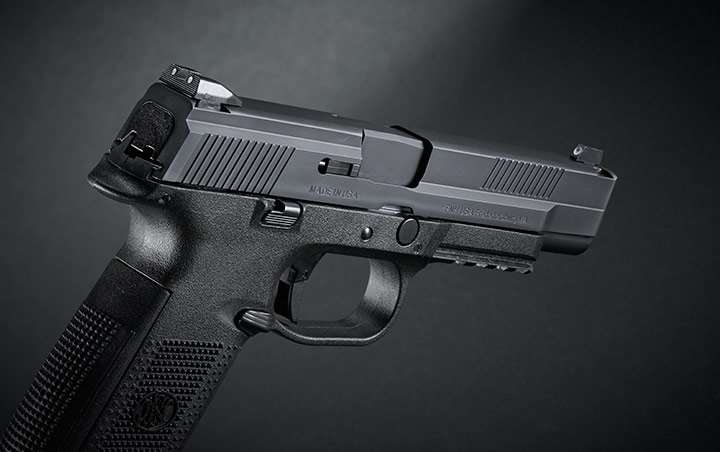
It's hard to look at the history of lightweight, polymer-framed, striker-fired pistols and not admire, indeed envy, their success. Even with the proverbial 800-pound gorilla still very much alive and in the game—we all know who that is—many others have found the military, law enforcement and civilian markets rewarding.
In this frame of mind, we then wonder: Why would another major player wait roughly two decades to join the polymer/striker fray? After all, in some arenas, this company is the 800-pound gorilla.
We think we’ve sussed out an answer, albeit in a very odd place—somewhere between John Milton and Robert Burns. Those “who only stand and wait” may well be planning to thwart “the best laid plans” of mice, men or unsuspecting competitors—and deliver a pistol as good as the FNS 9L.
Outside
At first blush, the American-made FNS 9L looks like what it is—a hammerless, steel above/polymer below auto-loading pistol. In our heads, we added “good-looking” too, but maybe that’s just us. Our particular sample was matte black—we presume a high-tech oxide—but matte silver is available too.
Closer inspection yields a harvest of great standard features, including fully ambidextrous controls. It took our industry a frustratingly long time to awaken to the need for these, and the execution of them on the 9L is excellent, although you need to use them on the range to fully appreciate some of their sophistication.
Of pistols in this class and type, the 9L also has a noticeably trimmer slide (by as much as .106 inch), especially the upper half forward of the ejection port. That might strike you as a “so what?” item, but we noticed in our shooting trials that slide manipulation remained sure for those of us with regular/biggish hands despite there being less, in a literal sense, to grab. A couple of small-handed volunteers, however, were emphatic in their appreciation of the narrow top.
In retrospect, we think this is a limited but real effect, and not some subjective, or even worse, transmogrified cosmetic preference. The benefit to malfunction clearing and overall handling safety accrues through two mechanisms. First are good cocking serrations. They are not our absolute favorites, but good, and plenty of them. Second is the taper from the narrow upper half to the wider lower half (got to have room for rails inside, right?) of the slide. This machined “step” provides more contact area for most slide manipulation techniques.
Think of it this way: You’re placing your gripping surfaces (fingers, etc.) in a shallow joint, where there are two surfaces with which to have contact. The result is more static friction, and hence more leverage. The least advantage is with a traditional “slingshot” (weak hand thumb and forefinger) technique, the most with a crossover grip forward of the ejection port. This latter is so secure that the pistol can be hand-cycled well faster than many can shoot it (10 rounds in well under two seconds).
Sights on our test pistol were a dovetailed pair of three dots: .125-inch blade in front, Warren-style “U” notch in the serrated-face rear. They are nothing fancy to be sure, but rugged and a much better start than some we could name. With the almost overwhelming variety now available (AW comparisons/reviews here, here and here), we have to spot manufacturers this one: There’s no point in trying to guess what most people would really like, and it’s impractically expensive to try. Tastes simply vary too much.
The polymer frame has an ample supply of well-executed features, too. Full ambi we already mentioned. In other words, magazine and slide releases are always available on both sides of the pistol, no switching required.
The trigger guard also stands out. It’s noticeably larger than most, and we can’t help but think how useful this will be for gloved use. Combined with a flatter-faced and more vertical trigger (in “prepped” position), fouling of glove finger material should be just about nil. Nicely undercut, it also helps to establish the high grip so effective in soaking up recoil impulse, and the straight press so useful to precise and/or rapid trigger actuation.
A studied observer might look at the grip of the FNS and conclude, “huh?” We would understand why. The texture design seems to borrow tidbits from a half dozen other pistols: pyramidal shapes here, vertical striations there, horizontals elsewhere, and logography thrown in to please the marketing/branding folks. It has swappable back straps too—one arched, one flat, both with lanyard loops.
A final detail: Of the fixed beavertail pistols, we like the FNS best. There’s plenty of material here to keep very meaty hands protected from “slide bite,” and also to render an over-high grip (with the same literally bloody result) essentially impossible. We raise the point because we know of a competing pistol—a pretty darn good one in many other respects—that arches the beavertail too far over the web of the hand. It feels great at the store or the armory, but doesn’t work well with the anatomy of some hands: We had no slide bite, but it left us blistered, then bleeding after only 120 rounds. This is old advice, but still sound: If at all possible, test shoot before you buy.
Inside
The inside of the FNS 9L is as reassuring as the outside, and getting a look at it is another simple pleasure. In a popular, usueful homage to the P38 (Walther, pre-WWII), takedown proceeds from an emptied, slide-locked pistol by means of a single, left side, frame-mounted lever rotated down and forward. Release of the slide lock and striker then allows the slide to come off the pistol to the front. So easy a caveman ... well, you get the idea.
The interior of the slide evinces no mysteries, though the radiused lower lock-up and what appear to be relief channels on both the barrel hood and slide strike us as clever indeed. They provide plenty of surface to be lubricated and bear wear and stress, yet ample room for combustion by-products and environmental contaminants to be cleared by slide action long before they can degrade functioning or accuracy.
In terms of surprises, the polymer frame has a few. Most obvious are the substantial frame rails. Not only are the rails much larger in surface area relative to competing designs, but they are replaceable, too. It speaks volumes about FNS’s confidence in the durability of their design that such a provision exists, but it also adds the ability—through a replacement of the rear set (which contains the striker release mechanism)—to field a version of the FNS with an ambidextrous external thumb-actuated safety.
We saw no indication whatever that such a safety is needed since the pistol already boasts the ubiquitous drop, disconnector and trigger safeties. Deduction leads us to the conclusion that certain commercial opportunities are enhanced by this capacity.
At The Range
While the FNS isn’t exactly a new pistol, there are not a tremendous number “out there” yet, and our experience with them is limited. Consequently, we warmed up as we would with a new design: function and projectile shape tests.
Function tests start with all possible round counts for the magazine, zero to X (where “X” is maximum capacity). Mainly the results tell us two things: Does the slide lock back as it should, and do all states of magazine spring tension still allow cartridges to chamber correctly (or, for instance, does the slide get balky with maximum up-pressure on it from a fully-loaded magazine)?
These tests also vary projectile type/shape as widely as practical to test whether particular projectile geometries and/or OALs make a given pistol malfunction.
With one rare exception (more on this later), the 9L was superb. We happened to have an unusually wide variety of 9mm ammunition available when we conducted these tests, and the FNS breezed through them. Short OALs were no issue, even down to 1.020 inches, while bullets as heavy as 162 grains stabilized well in the cold hammer-forged, 1:10 twist barrel. The barrel and long sight radius yielded superb accuracy too.
Once these basic functions of the pistol were vetted and we moved on to some tactical/practical exercises, the true excellence of the FNS 9L became apparent.
First, the mag release: This simple function and—you’d think—part, have alternately tortured and delighted designers and shooters for decades, but the best stock one we’ve yet seen is on the FNS. Yes, we actually said it—the best, period. The best stock one we’ve yet seen is on the FNS. Yes, we actually said it—the best, period.
The mag release is ambidextrous as we mentioned, but utterly without compromise on the 10-percenter side. The complexity of the shape at the micro level has an almost Frank Lloyd Wright sort of elegance—and functional excellence—at the macro level. Seriously: If you don’t take a look and think Guggenheim rotunda, we want to know what does come to mind. But we digress.
It’s the proper length: Our primary shooter may be the shortest-thumbed dude in the world, but even he can run it without a re-grip. Yet despite this length, it’s delicately recessed enough that we couldn’t induce an inadvertent mag release, nor find a grip that was a problem for the weak-side hand. We also failed to find any issues on the strong side: There was no back pressure fighting activation from the palm or knuckle of the trigger finger, and easy activation with the trigger finger on the master side if needed.
Next to impress us was the grip texture and architecture. The FNS lacks the swoopy curves and extensive girth variations of other pistols in the class, and only offers two backstraps. And as we noted, the texture seems like a hodgepodge of characteristics borrowed from other pistols. But our shooting results suggest all those options and consistencies on other pistols don’t fair that well by comparison. The exceptionally secure feel of the L9 grip is impressive, with dirt and contaminants overcome with particular ease. Nowhere is this more obvious than in either strong or weak hand-only shooting: This is where the small native dimensions and positionally optimized textures constitute a tangible advantage.
A caution here: If you just pick up an FNS, the texture may seem too aggressive. Certainly it did to us. But 700 rounds latter, we have one new, small callous, but wouldn’t change a thing. In any case, it’d be easy to knock the texture down a little if your accommodation was less complete than ours. (Beware that such a mod may not be legal for some competitive classes, however.)
The FNS does not boast a particularly light trigger, but it isn’t heavy either. Our scale showed 5.4 pounds—about average for a “stock” pistol in this class. But in our hands at least, the 9L performed like a much lighter trigger. We attribute this mainly to the verticality of the trigger face just as the shot breaks, and to a relatively short reset. The striker action is of the pre-set variety, wherein the striker is tensioned for firing by slide, not trigger, movement. Very few will even notice they’re releasing a safety during trigger press.
Short stroking was the only issue we encountered, and that very, very rarely. A little analysis linked this to one very specific batch of ammunition, and we were able to reproduce the issue in another brand of pistol, similarly sprung. So it was obviously an ammo “lot” issue.
This begs comment, though in two parts. First, always, always, always check your ammunition, as identically labeled lots vary, especially with powder availability as chancy as it has been the last two years. Anybody who tells you different is selling something, and perhaps a dangerous something.
Second, we don’t second-guess the spring rate/guide rod combination on the 9L at all in relation to this theoretic issue. “Why” is simple: With every other type of ammunition we tested, we found the FNS superbly, exceptionally flat in recoil over a huge range of bullet weights, types and powers, thumpy defensive loads included. In our experience, only “tuned” systems have been better, none by much, and none over such a wide range.
Gripes
We’re betting no one will be surprised by a short gripe list for the FNS 9L.
We had only one, to be precise. We found that the well-intentioned “guard” molded into the frame around the slide release over-protects the control from accidental activation. Paradoxically, our shooting grip is one that makes this a good feature. We found that more, or at least more precise, pressure was required to release the slide than we expected.
In fairness, we’d have to observe that release of the slide using the lever is a fine motor task, and hence suited only for administrative handling. Certainly we’d not call it any sort of deal-breaker, especially since sound technique will answer: When actually shooting, grasp the slide overhand from the weak side, pull it to the rear, and release it immediately (absolutely do not try to ride or push it forward, you’re far more likely to create a pinch or mis-feed hazard than to aid feeding). This no-slide-release-involved technique ought to be practiced a lot anyway for another obvious reason: It’s an absolutely crucial step in rapid, effective malfunction clearance.
We hold another gripe in abeyance. If you find yourself in a round count-limited state, you’ll see that the 10-rounders for your FNS series pistol are of the dimpled and body-cut variety. You may share our bitter experience following the 1994 Crime Bill: Expensive magazines could and did simply explode at the count-limiting cut, and unrepairably so. What should have been a warranty item infuriatingly wasn’t, and replacements were made—apparently—of unobtainium.
Looks to us as though the FNS mags are proof against these failures in two ways: The dimpling is a corrugation to the mag body, which in theory makes it stronger, while still limiting staggered round descent and hence round count. The nature of the cut is different too: Instead of being perpendicular and symmetric around the body, the FNS cut is angled, and much thinner (done by laser, we suppose) and intersects the large, offset dimples. This leaves more metal intact, and limits any flex below the fatigue level. We worked ours hard with no hint of difficulty. Bullet, dodged.
Final Analysis
After our range report, perhaps there aren't many surprises left. We think the FNS 9L is an exceptionally fine pistol.
A host of well-engineered and executed features set it above most peers. Overall trimness not only makes it easier for those with smaller hands above and below, but also more maneuverable in any prospective duty role. This fine trait will also help it find adopters that many previous pistols have effectively—if unintentionally—excluded from the striker-fired, double stack world. Don’t let the modest contours of the grip fool you. The FNS is fantastically secure in every remotely practical/realistic grip we could contrive, and especially comfortable and docile in single-handed use.
We wish we could describe our taste for the trigger with more clarity. Though it measures well, we liked it far better than it measures, and this will translate into rapid accommodation for a disproportionate number of those who step up to give it a try.
Suffice it to say that while the wait for a striker-fired Fabrique Nationale pistol was long, that patience is rewarded in every particular by the FNS 9L—an unalloyed masterpiece.




































